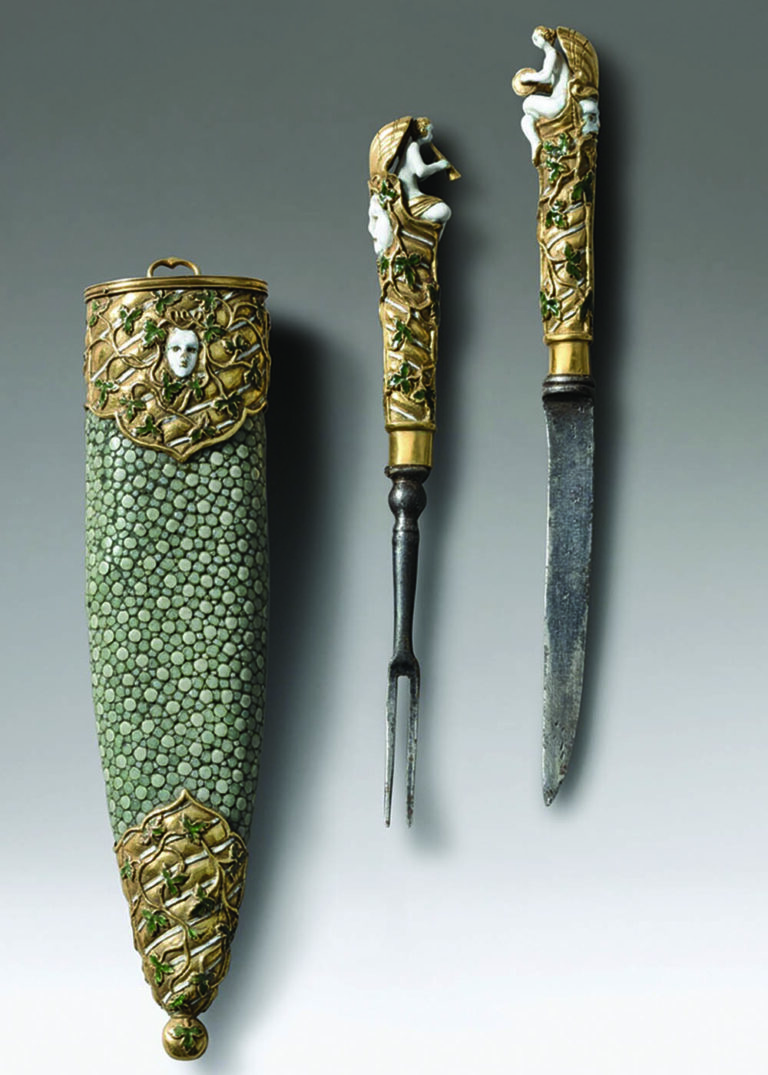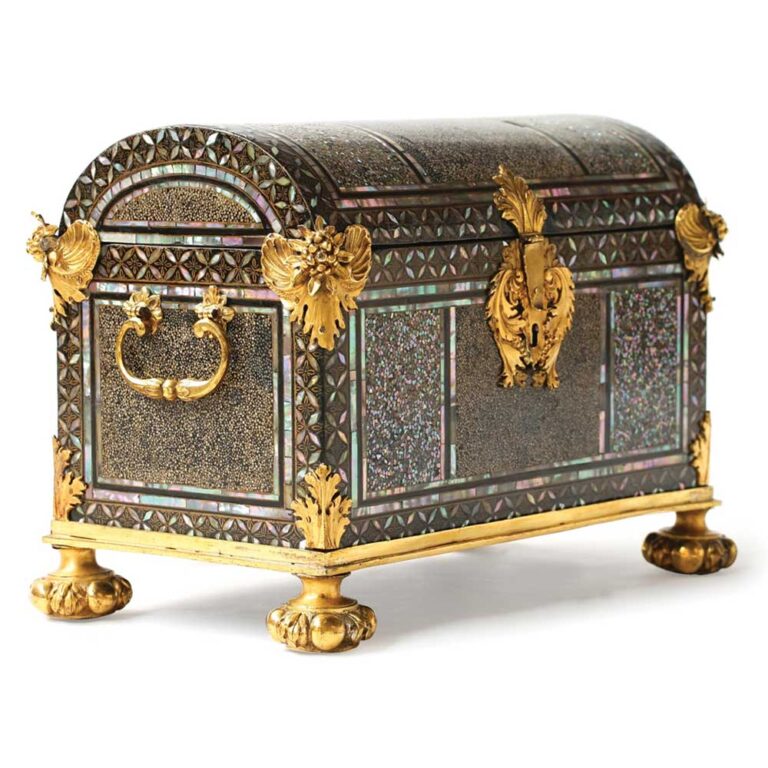A type of leather, shagreen is a natural material that’s been used for centuries. It’s thought the Egyptians were the first, after evidence was discovered in the 2000-year-old tombs of the pharaohs, but it became truly popular in the 1700s.
The term ‘shagreen’ typically refers to the rawhide of an animal with a rough, pitted surface, but is most commonly applied to the treated skin of the ray fish or shark. Its rough, textured surface made it a perfect material for the Japanese to use on their samurai sword grips and scabbards, a practice that began in the 13th century. Raw hides were also used to cover small items such as boxes, knife handles, books and shaving kits. Until the dyes used on shagreen were developed in the 17th century, shagreen with the whitest hide was considered to be the most valuable.
The earliest known examples of furniture decorated with ray skin were produced in Japan for export to the European market and were traded in the late 16th century by Portuguese merchants. The shagreen was usually incorporated into the lacquer finish that was popular in the western world at the time, with the furniture taking the forms that would be familiar to the European buyers: domed lid coffers, drop front cabinets and small chests of drawers. The shagreen would be embedded in the lacquer, which allowed large areas to be covered with an even pattern and no seams between the skins. The scales and lacquer were then polished to a smooth, uniform surface.
Made in Europe
For some decades in the 17th century, the Dutch East India Company ran a lucrative sideline trading ray skin. Between 1633 and 1663, exports from a trading post set up in Thailand to an office in Japan numbered nearly half a million skins. One documented transaction reports the rejection in Japan of more than 8000 skins from a shipment of 9000, with the rejected skins more than likely being moved on to Europe, where they would have been used to cover small objects; shagreen was a popular covering for microscopes and other scientific instruments.
The French connection
There’s nothing like popular sentiment to move a market, even in the mid-18th century, and after Madame de Pompadour – mistress to King Louis XIV and renowned patron of the arts – discovered green-polished shagreen she became an advocate, purchasing a variety of shagreen covered items from French master leatherworker Jean-Claude Galluchat (1689-1774) who worked for the royal court. Such was the popularity of his snuff boxes, humidors and opera glasses that Galuchat (with one ‘l’) became the term by which shagreen was known in France (and remains so today).
The European craftsmen used the skins intact, as opposed to removing and sprinkling the scales. The skin was usually dyed – green was the most popular, but pink and other colours were also used – and the denticles were usually ground down. Sometimes a piece of coloured paper was placed behind the translucent skin. It also became popular to feature shagreen as part of the decoration on pieces of silver, in much the same way that enamel or glass were used.
Deco designers go green
The Parisian Art Deco movement was responsible for shagreen returning to the limelight in the 1920s, with designers such as modernist Jean-Michel Frank, decorator Andre Goult, Paul Iribe and Clement Rousseau using it for decorative highlights on furniture. They stretched the skins over the curves of their furniture, using the central ridge of larger scales to emphasize geometric elements of the design and making a feature of smaller skins by arranging them in patterns. Chairs, cabinets and tabletops were all covered with shagreen, which was all the more remarkable given they had no prior knowledge of how to prepare or use the skins; Iribe, who was working as an illustrator, designer, decorator and art director in New York, had purchased an old stock of skate skins from a Parisian skin merchant and persuaded Rousseau to work with them in his furniture designs. Working alone and with no treatise to follow, Rousseau revived the 18th century art of galuchat and it became his trademark, producing pieces for glamorous Deco figures such as Robert de Rothschild and the Duchess de Vendome. His items are rarely seen on the market due to his extremely limited output.
In 1926, French historian Gaston Derys wrote of the bedroom of Napoleon III at the Chateau de Tuileries, describing how it took craftsmen three years to prepare and apply the skins for his bedroom. He wasn’t alone in his regal appreciation of the skin; the Aga Khan had it installed into the interior of his Rolls Royce.
Ray skin or shark skin?
Although most items are described simply as ‘shagreen’, there’s a discernible difference between ray and shark skin. Ray skin is thicker and has larger, rounder and bonier denticles, compared to the small, rhombic denticles of shark skin. The ray skin scales are closely set in a fairly random arrangement, whereas shark scales are arranged in regular rows that point in the direction of the tail and are separated by furrows.
As early as the mid-19th century, shagreen imitations were being produced. Examples could be made from printed and varnished papers, early plastics, vinyl or embossed mammal leather. Today there is an imitation produced in cast resin, although it tends to lack the translucency and subtleties of the real thing.
Or perhaps a horse…
It has often been suggested that the term ‘shagreen’ is derived from the French ‘chagrin’. However… scholars consider it far more likely to have originated from the Persian ‘saghari’ or the Turkish ‘sagri’. You may well be wondering why… and the answer is because in its earliest form the material was a type of untanned horse or donkey leather, and ‘saghari’ and ‘sagri’ both describe embossed donkey or ass leather.
Ref: Shagreen. The history and conservation of decorative ray skin in furniture, Cathy Silverman. www.silverman_LR.


